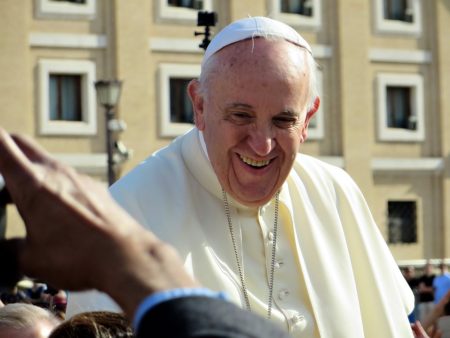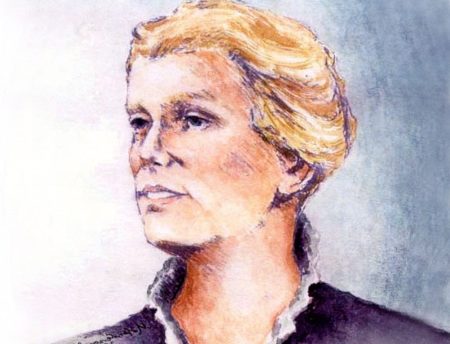“I believe this is the time for mercy”, words spoken by Pope Francis in his ninety-minute interchange with journalists on the plane journey back to Rome from the World Youth Gathering in Brazil some years ago. (Pope Francis)
Something new something old!
Why are journalists and TV presenters as well as the ordinary people in the street willing to say?
“We all love Francis”
The message that Pope Francis shares is “old” but the “tone” is new and this it seems is what has caught peoples’ imagination today.
People respond, not only to the words that Francis uses, but also are also fascinated by the way he actually lives what he says. Stories abound about his simple, uncluttered way of being and doing, which is a mercy-filled way of living.

He feeds the hungry – Francis told the monsignor in charge of almsgiving in the Vatican (a charity funded by the money people pay to get a papal blessing) to use up all the money he had to hand and even to sell off his desk in order to feed the poor of the day. He told him in the same breath to move out of his office, to walk the streets around the Vatican, to meet with and talk to the poor he met there and to come back and let Francis know what the needs of the poor on the street were.
As a result of this “research”, Francis provided showers for the poor in a number of locations throughout the city of Rome. He also followed through on placing a phone card in all the food parcels distributed by the Vatican one Christmas. This enabled many migrants living on the streets in Rome to phone home or to phone someone they knew for Christmas courtesy of Pope Francis!
He hugs the sick and spends time listening to them – the picture of Francis hugging a man suffering from external tumours went viral. He gives over the longest part of his weekly audience in St. Peter’s Square to greeting and talking to the sick and the people who take care of them.
He visits those in prison and washes their feet – One year, during the Easter Triduum, he broke with tradition by going out to one of the prisons in the city for the evening mass and washing the feet of women and men there.
For Francis, mercy is the prism through which he communicates and gives expression to the love of God that flows through him. Quoting Thomas Aquinas in Evangelii Gaudium (39, 40) he says,
“As far as external works are concerned, mercy is the greatest of all the virtues since all the others revolve around it and more than this, it makes up for their deficiencies”.
Something old, something new!
These examples of Francis’ actions in our own day only serve to highlight what Catherine McAuley must have looked like to the people who knew her while she lived.

The Mercy genius in Catherine shines through in the practical ways she too lived the spiritual and corporal works of mercy. Walter Kasper (2012) notes that St. Benedict in his Rule adds a fifteenth work of mercy, which is “never ever despair of the mercy of God”, a phrase we hear very often on the lips of Francis and from Catherine
“What would the charity of God have profited us, if His mercy had not come to our aid?” (Catherine McAuley)
“The tender mercy of God has given us one another” (Catherine McAuley)
What of the Mercy Charism Today?
One of the reasons why we stay with promoting the cause for beatification of Catherine today is because of the gift of the charism of Mercy that she received and to which she responded with all her heart. When Catherine is canonised, the story of how she lived her life will spread to a far wider audience than exists today. This is the purpose of canonisation that the specific gift/charism of the Holy Spirit to the Church, visible in the lived experience of the saint becomes accessible to the ordinary person, living an ordinary life, in any part of the world where the Church lives.
Pope Francis gives witness to the fact, and we know from our own experience that Mercy is needed as much in our time as in Catherine’s.
While we know, it is not the whole story and In spite of energetic efforts to alleviate the ills of society, in our day we see poverty, sickness, violence and addiction abound. People are alienated, lonely, uprooted, deserted and abused. We see technology used to cover destructive behaviour towards others. Most importantly, we see erosion of faith in God.
What can we do?
Taking our example from Catherine, we see that she brought her heart to suffering wherever she met it. She was concerned for both the spiritual and temporal welfare of people around her. She connected the rich with the poor, the healthy to the sick, the educated to the uninstructed, and the powerful to the weak. “She did it one person at a time, one answering of the figurative doorbell, one opening of the figurative door, one embrace of the stranger, one welcoming of the other, one sharing of our bread and milk, one person at a time”. (Mary Sullivan rsm)
Can we do the same?
Status of the Cause

The work on Catherine’s cause for beatification slowed down appreciably during the pandemic. We are still in the process of preparing the material of the extraordinary favour that happened in 2015. The summary of all medical reports is now at the revision stage. The next step is the presentation of the collated material to the Consulta Medica, which makes the decision as to whether the favour we are dealing with is acceptable or not. Please keep the prayers going for the successful outcome of this stage of the process.
Brenda Dolphin
Postulator for the Cause of Catherine McAuley


